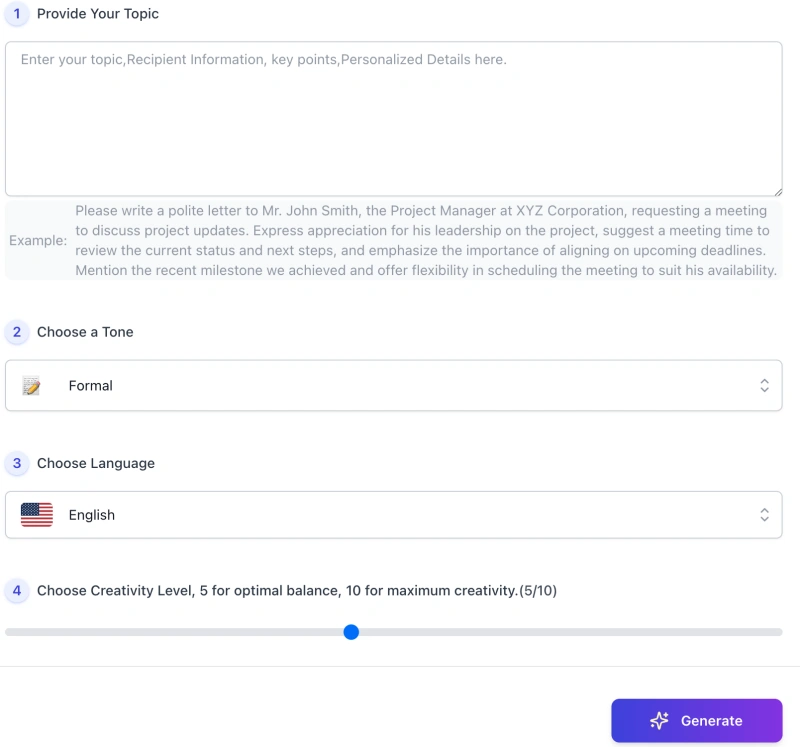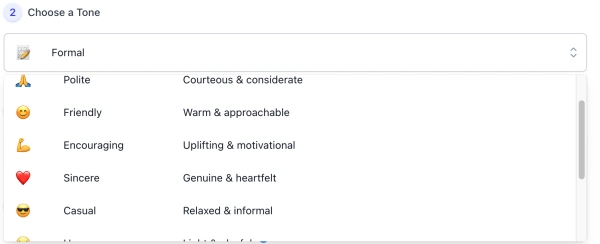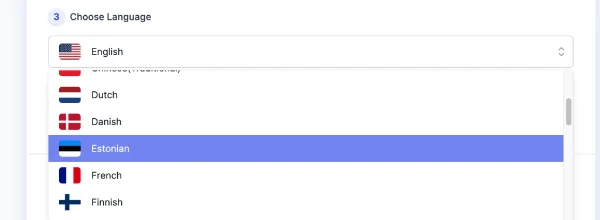Free AI Tools. No Sign-Up Required. Full Access.
AI Letter Writer Generator
Free AI tool to write professional and personal letters online — no sign-up, perfect for work, study, or daily communication.
Combine the current tool with these other tools to work more efficiently.
Discover other tools with functions and purposes similar to the one you are currently viewing.
- AI Email Writer Generator
- AI Love Letter Generator

- AI Writer Generator
- AI Letter of Recommendation Generator

- AI Paragraph Writer Generator
- AI Cover Letter Generator

- AI Write Message Generator
- AI Essay Writer Generator

- AI Writing Assistant
- AI Text Generator

- AI Speech Writer Generator

- AI Continue Writing Generator

Discover the tools most favored and highly-rated by users on our website.
Explore more AI tools in these related categories
AI Writing tools generate, or enhance text content for various writing tasks.
AI tools that improve grammar, style, clarity, and overall quality of written content.
AI tools for creating, optimizing resumes, cover letters, and other professional documents.
This is AIFreeBox AI Letter Writer Generator Page — an online tool designed to help you write letters that feel structured, emotionally appropriate, and true to your intent. Available on Free & Ultra Plan.
On this page, you’ll find everything you need to understand what the tool can do, how to use it effectively, where it works best, and what to watch out for. We also cover writing tips, known limitations, practical troubleshooting, and FAQs.
What Can AIFreeBox AI Letter Writer Generator Do?
Built on transformer-based large language models and fine-tuned for letter writing, this tool is designed to support real-world communication—not just text generation. It helps users plan and compose letters that follow a clear structure, reflect the right tone, and express intent with emotional clarity.
With support for 33 languages and 15 distinct styles, it adapts to a wide range of personal and professional situations. Whether you’re requesting, apologizing, congratulating, or simply reaching out, this tool supports real-world communication by guiding tone, form, and clarity.
At its core, the design philosophy is simple: writing a good letter isn’t about fancy words — it’s about saying the right thing, in the right way, to the right person. This tool exists to help you do exactly that.
Practical Scenarios Where This Tool Fits
| Use Case | Who It’s For | How This Tool Helps |
|---|---|---|
| Job Applications e.g. cover letters, recommendation requests |
Job seekers, students, interns | Helps structure letters professionally while keeping them personal and goal-focused |
| Customer Communication e.g. apology letters, delay notifications |
Support teams, small business owners | Guides tone and clarity in sensitive messages to maintain trust and empathy |
| Personal Messages e.g. thank-you notes, emotional support |
Everyday users, friends, family members | Provides a way to express feelings clearly without sounding awkward or generic |
| Formal Requests e.g. remote work, academic leave, visa support |
Employees, students, professionals | Ensures the tone is respectful, structured, and suitable for formal communication |
| Business Letters e.g. proposals, announcements, follow-ups |
Managers, freelancers, entrepreneurs | Helps communicate clearly with consistency and a professional tone |
| Apologies & Accountability e.g. personal or public apologies |
Individuals, public figures, brands | Offers a sincere and respectful way to acknowledge mistakes and move forward |
| Multilingual Writing Support for 33 languages |
Non-native speakers, international teams | Makes it easier to write clear, culturally appropriate letters in other languages |
How to Use AIFreeBox AI Letter Generator: Step-by-Step Guide

1. Provide Your Topic and Details
In the first box, briefly describe the purpose of your letter, who it’s addressed to, what you want to say, and any personal or contextual details. The more specific you are, the more accurate and helpful the result.
Example: “Please write a polite letter to Mr. John Smith, the Project Manager at XYZ Corporation, requesting a meeting to discuss project updates. Express appreciation for his leadership, suggest a time to meet, and highlight the importance of aligning on upcoming deadlines.”
2. Choose a Tone That Matches Your Intent

Select from 15 available tone styles to match how you want the letter to sound — whether formal, friendly, persuasive, or apologetic. The tone will shape the structure, phrasing, and emotional feel of the output.
3. Select Your Language

The tool supports writing in 33 different languages. Choose your preferred language to ensure the letter is expressed appropriately for your audience or situation.
4. Adjust the Creativity Level
Use the slider to control the level of creativity. A level of 5 is balanced and ideal for most real-world letters. Higher levels (closer to 10) introduce more expressive or unconventional language — useful for personal or emotional letters.
5. Click “Generate” to Create Your Letter
Once your inputs are ready, click the Generate button. The tool will produce a complete letter tailored to your details, tone, and language. You can copy, edit, or regenerate as needed.
6. Report Bug or Feedback (Real Human Support)

If something looks wrong (loading error, formatting issue, missing sections), click “Report Bug“. A real support teammate will review and respond. Please include:
- Your input (sanitized if needed)
- What you expected versus what you saw
- Browser/device info and a screenshot if possible
We use these reports to improve prompts, templates, and rendering. Your feedback directly shapes the tool.
Before you send it out, take a moment to review the generated letter. Use it as a solid starting point, and make any edits needed to ensure it fully reflects your voice, intent, and the context of your message.
Tips for Better Letters
- Be specific with your intent
Vague prompts lead to vague letters. Clearly state what you want the letter to accomplish — whether it’s a request, an apology, a thank-you, or something else. Make the core message unambiguous. - Include important details
Mention names, roles, dates, or specific context where relevant. These details help the letter feel personalized, grounded, and appropriate for the recipient. - Choose the tone with care
Tone shapes how your message is received. If you’re unsure, choose one that reflects your relationship with the recipient — formal for professional, sincere for personal, supportive for difficult conversations. - Start with level 5 creativity
Level 5 strikes a balance between structure and expression. You can increase it later for more expressive or emotional letters, but it’s a solid place to begin for most use cases. - Edit before sending
Think of the generated letter as a draft, not a finished product. Review it carefully and adjust anything that doesn’t feel quite right — your voice still matters.
From Input to Letter: A Real Use Example
Scenario
Emma is a project coordinator who needs to request an extension on a report deadline. She wants to sound respectful, acknowledge the delay, and explain the reason without sounding careless.
What She Entered
Please write a polite letter to Mr. Chen, my team supervisor, requesting a 3-day extension for submitting the Q3 progress report. Mention that I’ve been managing multiple urgent requests this week, and that the draft is already 80% done. I want to assure him I’ll use the extra time to improve quality and meet expectations.
What the Tool Generated
Dear Mr. Chen,
I hope this message finds you well. I’m writing to respectfully request a short extension of three days for submitting the Q3 progress report. This week has involved several time-sensitive priorities, and while the report is nearly complete, I believe a brief extension will allow me to refine the content and ensure it meets our quality standards.
I appreciate your understanding and flexibility, and remain committed to delivering work that reflects our shared expectations.
Sincerely,
Emma
How She Adjusted It
Emma kept the overall structure but added a short sentence in the opening to acknowledge a recent team success, and changed the closing line to sound a bit more personal. The final version felt like her own — supported by the tool, not written by it.
Takeaway
This tool doesn’t replace your intent — it helps express it clearly. Your inputs guide the structure, tone, and focus. Use the output as a first draft, and shape it into something that truly reflects your message.
Style System Overview
- 📝 Formal — Professional and respectful; suitable for business, academic, or legal contexts.
- 🙏 Polite — Courteous and considerate; ideal for making requests or declining offers kindly.
- 😊 Friendly — Warm and approachable; good for informal letters to colleagues or acquaintances.
- 💪 Encouraging — Uplifting and supportive; helpful when motivating or reassuring someone.
- ❤️ Sincere — Genuine and heartfelt; suited for personal notes, thanks, or apologies.
- 😎 Casual — Relaxed and conversational; best for writing to friends or peers.
- 😂 Humorous — Light and playful; adds charm to non-serious or friendly messages.
- 🗣️ Persuasive — Convincing and logical; useful for recommendations, proposals, or support letters.
- 💖 Emotional — Deeply expressive; effective when conveying strong feelings or personal reflections.
- ⚖️ Neutral — Objective and factual; appropriate for formal notices or straightforward communication.
- 🔒 Respectful & Assertive — Firm yet polite; great for setting boundaries or handling complaints professionally.
- 😔 Apologetic & Accountable — Humble and responsible; fit for sincere apologies or acknowledgments of fault.
- 🎉 Celebratory & Grateful — Joyful and appreciative; ideal for congratulations, milestones, or gratitude.
- 🤝 Empathetic & Supportive — Understanding and kind; works well in difficult situations or emotional support.
- 🚀 Confident & Ambitious — Bold and forward-looking; perfect for resignations, announcements, or visionary appeals.
- 🌀 Sarcastic & Ironic — Witty and ironic; best used in creative or informal contexts with the right audience.
Limitations & How to Handle Them
| Limitation | What You Might Notice | Suggested Fix |
|---|---|---|
| Generic or vague output | The letter feels too broad or lacking detail | Add more specifics in your input — include names, context, and purpose clearly |
| Tone doesn’t feel quite right | Message sounds too formal, casual, or emotional for your situation | Try a different tone option, or adjust the wording after generation to better match your voice |
| Too short or too long | The letter doesn’t match your expectations in length | Use the creativity level slider — higher for more expressive content, lower for concise structure |
| Repetitive or stiff phrasing | Some sentences feel unnatural or overly templated | Edit the final draft for flow, or regenerate with varied input phrasing |
| Doesn’t fully reflect your intent | The letter misses a key message or emotional nuance | Review the output carefully, and don’t hesitate to reword or reorganize before using it |
FAQs
Is the letter ready to use as soon as it’s generated?
Not always. The generated letter is a solid first draft based on your input, but reviewing and editing it ensures it fully reflects your voice, priorities, and context.
What if the tone doesn’t feel quite right?
Try selecting a different tone option and regenerate. Tone affects word choice and structure — testing a few styles often helps you find the best fit.
Can this tool write formal letters for legal or visa purposes?
It can help you outline structure and tone, but for high-stakes letters, we recommend reviewing the content carefully or consulting a professional before sending.
Does it work for emotional or personal messages?
Yes, especially if you provide enough detail. The tool supports emotional tones like sincere, encouraging, or apologetic, but your input will guide how genuine the output feels.
How do I get better results?
Be clear about what you want the letter to do — include who it’s for, what it should say, and any key context. The more specific your input, the more accurate the output.
Can I write letters in other languages?
Yes. The tool supports 33 languages. Just choose your preferred language from the dropdown before generating.
Is my data saved or used elsewhere?
No. Your input is not stored or used for training. This tool is designed to assist in real-time and does not retain any personal information.
Is this a replacement for professional writing?
No. This tool is designed to assist, not replace. It helps you organize thoughts, choose tone, and generate a starting point — your judgment and final edits still matter.
Creator’s Note
This tool wasn’t built to automate writing — it was built to support it.
Letters carry intent, emotion, and often responsibility. That’s something no model can fully own. What this generator offers is structure, tone guidance, and a place to begin — not a final say.
Whether you’re writing to ask, to thank, to apologize, or to reconnect, your words still matter the most.
I created the AI Letter Writer Generator to make it easier for more people to say what they mean, clearly and respectfully. It’s here to assist — quietly, consistently — and always in service of your voice.
2025-10-23
✉️ Try it out now — free, online, and ready when you are.
Write letters that sound natural and sincere — let AI help you find the right words for every occasion.